Aristotle’s timeless wisdom, “Well begun is half done,” holds special relevance in affiliate partnerships. Your program’s first impression can set the tone for the entire collaboration. Miss the mark here, and each hiccup risks alienating partners and diminishing the value they bring.
At its core, affiliate onboarding is about eliminating friction by creating a seamless experience that ensures affiliates feel supported, confident, and ready to succeed. Effective onboarding requires a roadmap showing partners how to become high-performing members of your partnership program.
When done right, great onboarding leads to:
- Faster productivity: Affiliates start promoting your brand sooner.
- Higher engagement: Clear guidance keeps partners motivated.
- Stronger retention: A streamlined experience builds long-term loyalty.
So, what’s stopping brands from effectively onboarding affiliates? Let’s break down the biggest challenges and explore strategies for fixing them.
The 4 biggest affiliate onboarding challenges (and proven solutions
Bringing new affiliates into your program should be smooth. However, common onboarding challenges—from clunky manual processes to unclear performance tracking — may slow productivity and impact long-term engagement.
The good news is that each challenge has a solution. Here’s how to overcome the common onboarding obstacles and ensure your affiliates hit the ground running.
Challenge 1: Manual processes slow onboarding efficiency
Delays and errors caused by inefficient workflows can frustrate affiliates, disrupt their ability to start earning and diminish trust in the partnership. Manual onboarding processes contribute to these bottlenecks and often involve time-intensive tasks, such as:
- Entering affiliate details into systems
- Validating affiliate-provided information
- Setting up campaigns manually
- Managing contracts and legal agreements
- Tracking and confirming payment details
The onboarding process becomes unnecessarily complicated when your team relies on spreadsheets, back-and-forth emails, and other outdated methods. These setbacks strain relationships and risk revenue opportunities and long-term engagement, making a poor onboarding experience costly for both sides.
Practical solutions:
Streamline registration: Use custom online forms to gather affiliate details and required documents in one step.
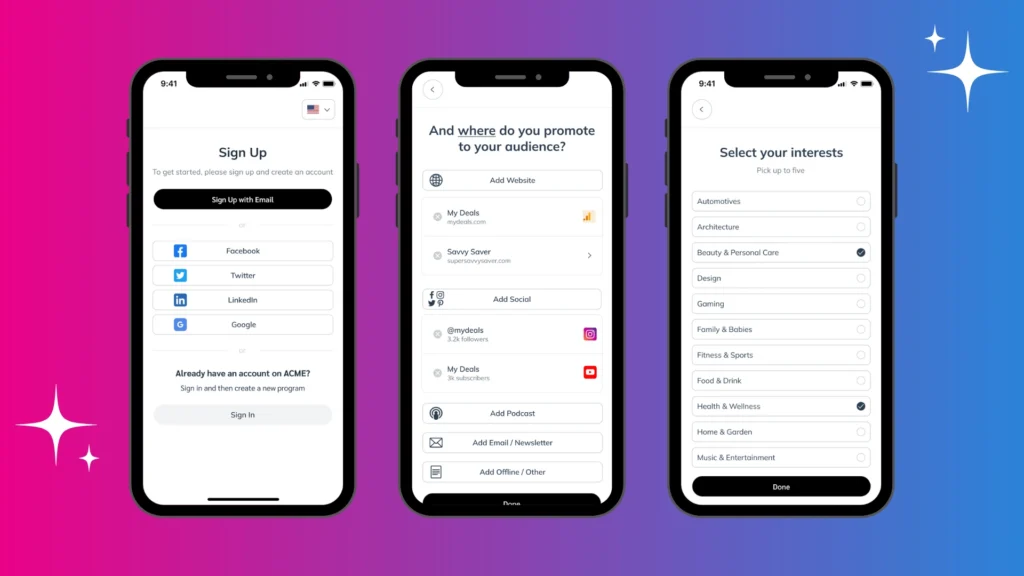
Platforms like impact.com help you create customized sign-up experiences to develop and nurture direct relationships.
Digitize contracts: Implement digital templated contracts that allow affiliates to sign agreements easily. When Semrush migrated to impact.com, the platform’s multiple contract terms streamlined the approval process by differentiating partners migrating from the previous program and new partners, onboarding over 1,000 partners seamlessly.
Automate account activation: Enable instant approvals and onboarding workflow, so new affiliates can access their dashboards and start promoting sooner.
Centralize communication: Use a single platform for onboarding updates and queries to reduce back-and-forth emails.
Challenge 2: Lack of training impacts affiliate readiness
Affiliates often face a steep learning curve when joining a program. Without proper training, they may feel overwhelmed, unsure of how to promote effectively, or unaware of the available tools and resources. This lack of guidance can lead to delays in launching campaigns, reduced confidence, and early disengagement.
When affiliates don’t receive clear, structured training, they’re left to figure things out on their own, which can result in:
- Misaligned strategies that fail to drive results.
- Missed opportunities to optimize campaigns early.
- A lack of trust in the program’s ability to support its success.
A strong training foundation ensures affiliates feel equipped, confident, and ready to contribute from day one.
Practical solutions:
Host interactive onboarding webinars: Conduct live sessions where affiliates can ask questions, learn best practices, and see real-time demonstrations of tools and processes.
Create a comprehensive training hub: Develop an easily accessible library of resources, including FAQs, how-to guides, and video tutorials tailored to different affiliate experience levels.
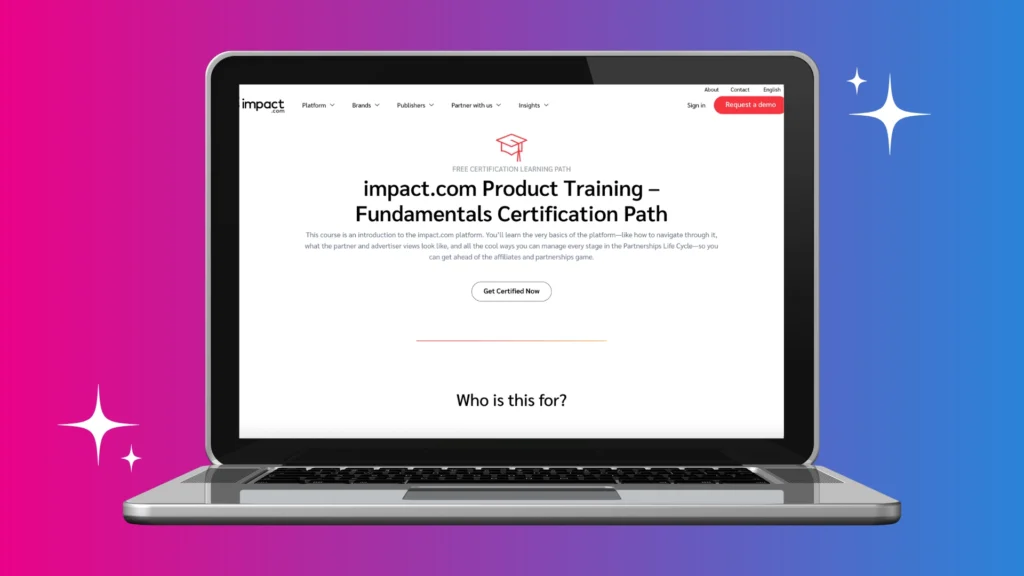
Using platforms like impact.com provides both you and your partners with access to industry and platform training through PXA, enhancing onboarding efficiency and expertise
Assign dedicated onboarding coaches: Pair new affiliates with onboarding specialists who can provide personalized guidance and address specific challenges during their first month. Management solutions often have dedicated teams to optimize the onboarding experience. For instance, the impact.com onboarding team provided B&Q with extensive virtual training to ensure proficiency with the new platform. Quick response times and weekly calls helped monitor performance in the early stages of onboarding, identifying gaps in top-performing partners who still needed to be onboarded.
Incorporate gamified learning: Use quizzes, challenges, or rewards to make training engaging and encourage affiliates to complete key learning milestones.
Provide reporting tools as a training resource: Equip affiliates with dashboards that track performance and include tips and insights on how to interpret data and improve results.
Challenge 3: Complex integration deters affiliate engagement
Affiliates are usually eager to start promoting. But technical barriers can kill that momentum fast. Confusing setup processes create friction from the start. Affiliates who can’t easily connect their platforms or track performance may abandon the process altogether, leaving you with fewer active partners.
Minor technical barriers such as unclear instructions, broken links, or missing integration support can demotivate affiliates. The longer it takes to setup affiliates, the slower they are to launch campaigns and start driving results. Worse, affiliates who struggle during onboarding are more likely to disengage entirely, reducing the overall effectiveness of your program.
Practical solutions:
Provide step-by-step setup guides: Share clear instructions for generating tracking links, connecting platforms, and optimizing tools to guarantee a smooth onboarding process.
Create how-to videos and tutorials: Visual walkthroughs help address common setup tasks and troubleshooting tips.
Offer hands-on onboarding support: Assign live chat or dedicated representatives to assist affiliates with real-time setup challenges.
Leverage plug-ins and automation tools: To reduce manual effort, use integrations that automate tasks like tracking link generation and platform syncing.
Continuously optimize the process: Gather affiliate feedback to identify pain points and refine the setup experience regularly.
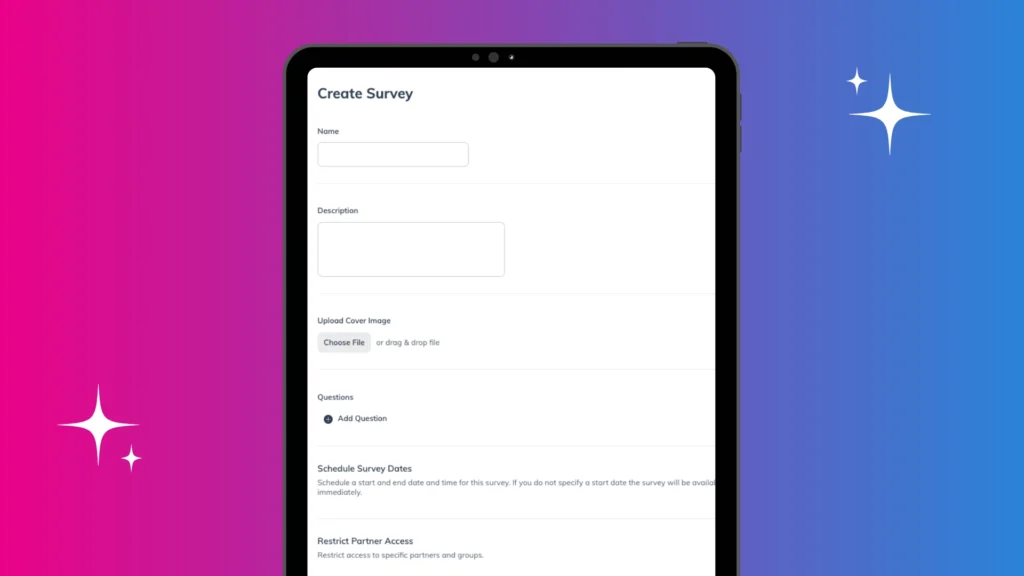
Surveys by impact.com allow you to collect information from partners to improve or streamline your business.
Challenge 4: Long ramp-up times delay affiliate productivity
Completing onboarding is just the first step—activating affiliates and enabling them to deliver results is where the real value lies. Without a clear post-onboarding plan, affiliates may feel stuck, and unsure how to launch campaigns or optimize their efforts.
A well-structured activation plan ensures affiliates can hit the ground running, driving early wins and building long-term program success.
Practical solutions:
Develop an “Affiliate Activation Roadmap”: Provide a clear timeline with actionable steps for affiliates to follow after onboarding, such as launching their first campaign or tracking initial results.
Host orientation webinars: Live or recorded sessions on affiliate marketing best practices (tailored to your brand) help affiliates understand how to promote effectively and maximize earnings.
Share ready-made marketing assets: Provide pre-designed banners, email templates, and social media kits to make it easy for affiliates to start promoting immediately.
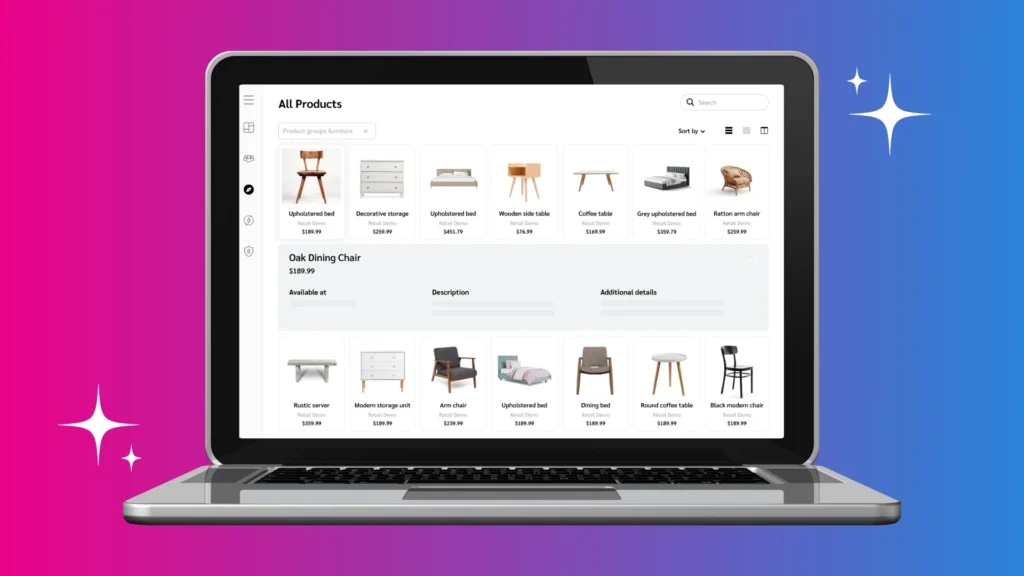
Curated Product Catalogs save your partners time and guide their activity by telling them which products to promote.
Check-In during the first month: Proactively reach out to affiliates to address any challenges, celebrate early wins, and keep them motivated.
Incorporate performance milestones: To build confidence and momentum, set achievable goals for affiliates to hit within their first 30 days, such as generating a specific number of clicks or conversions.
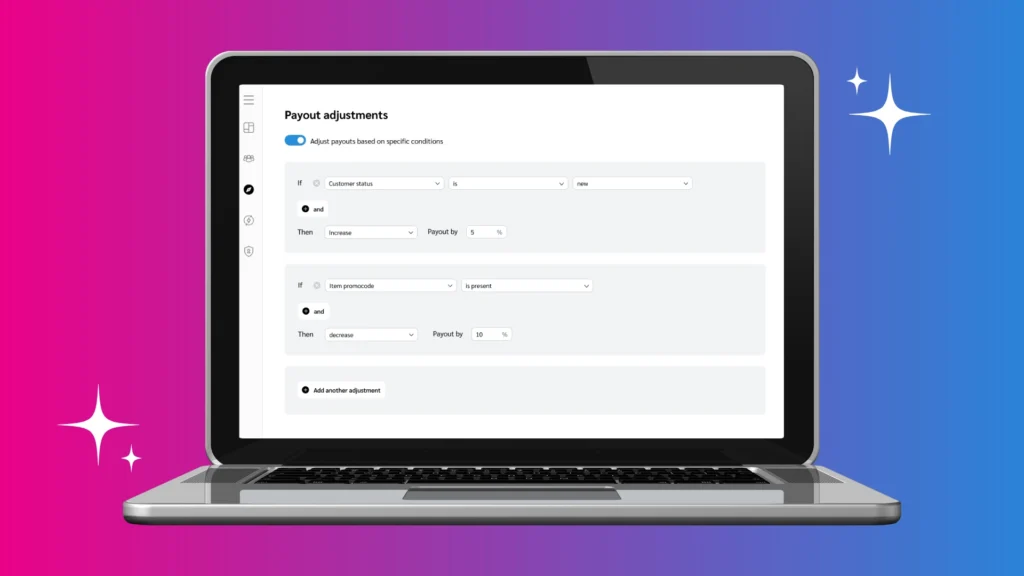
Use Dynamic Payouts to adjust partner commission to reward all contributions
Measuring successful affiliate onboarding: Key metrics and benchmarks
Onboarding is only as good as what happens after it ends. If affiliates aren’t promoting, converting, or even logging in a few weeks later, that’s not onboarding. That’s leakage.
Tracking the right metrics over time helps you see what’s working and where new partners are falling off. It also gives you the information needed to adjust your onboarding process, reduce drop-offs, and build a more reliable partner experience.
What to track during the first 30, 60, and 90 days
Forget vanity numbers. These are the metrics that actually move the needle when it comes to affiliate onboarding success. Breaking them down across the first three months gives you a clearer picture of where things are clicking—or stalling.
First 30 days
You’re looking for early signs of momentum or friction.
- Time to first promotion: Are affiliates launching a campaign within their first week, or are they still waiting on assets or approval?
- Training completion rate: Are they finishing the onboarding content, or bouncing halfway through?
- First login time: Are they logging in right after approval or disappearing for a week?
- Drop-off rate: Who signs up but never engages? Where’s the process breaking down?
Day 31 to 60
This is where traction should kick in.
- Time to first-click: How fast are campaigns starting to drive traffic?
- Engagement metrics: Are they logging in, downloading assets, staying active?
- Support requests: Are common questions popping up? That’s a sign something’s unclear in your setup flow.
Day 61 to 90
You’re looking for consistency now.
- Time to first conversion: Has their campaign delivered a sale yet? If not, what’s the hold-up?
- Campaign cadence: Are they posting regularly or did they test once and vanish?
- Activation rate: How many affiliates are still actively promoting by the third month?
- Revenue contribution: Even a small result here means your onboarding is working.
These numbers give you a practical snapshot of how affiliates progress after that first touchpoint.
How to set baselines and improvement goals
Start by analyzing your current data. Look at the performance of your onboarding process over the last few months to uncover patterns and areas for improvement. For example:
- What is your average time to first conversion?
- How many affiliates remain active beyond 90 days?
- Where do partners typically encounter obstacles during onboarding?
These insights provide a baseline to measure progress and refine your strategy. From there, set realistic improvement goals. For instance:
- If your average time to first promotion is 12 days, aim to reduce it to 9 days.
- If 60 percent of affiliates complete training target a 75 percent completion rate for the next quarter.
Focus on incremental progress rather than perfection. By breaking down goals into manageable steps, such as improving one aspect of the process at a time, you can create meaningful shifts in performance. Continuously monitor these metrics, adjust based on your results, and use the insights to fine-tune your onboarding experience.
Tools and dashboards to track affiliate onboarding metrics
To effectively track affiliate onboarding metrics, the right tools can streamline data collection, identify bottlenecks, and provide actionable insights. Here are several options to consider:
1. Management platforms (e.g., impact.com)
Platforms such as impact.com have built-in dashboards that offer a comprehensive view of affiliate data. For instance, the Partner Applications Report displays all your partner application information, including KPIs such as earliest action, applications, and retracted offers. The platform lets you monitor onboarding milestones and quickly address drop-offs, making it ideal for program managers looking for an all-in-one solution.
2. Google Analytics
While not specifically for affiliate onboarding, Google Analytics can help track web traffic generated by new affiliates during their first campaigns. Custom UTM parameters allow you to measure click-through rates and conversions tied to specific onboarding efforts, filling gaps where more detailed affiliate-specific tools might not suffice.
3. CRM platforms with affiliate tagging (e.g., Salesforce or HubSpot)
Assigning custom fields or tags to affiliates within your CRM makes it simple to track onboarding stages. For instance, you can label affiliates as “just signed up,” “completed training,” or “first campaign launched” and easily filter their progress over time.
4. Business Intelligence tools (e.g., Tableau or Looker)
BI tools can analyze affiliate performance trends over time. By integrating your affiliate program data, these dashboards provide detailed reports on training completion rates, promotion launch times, and campaign cadences across your entire program.
5. Survey platforms (e.g., Typeform or SurveyMonkey)
Surveys are a valuable way to gather affiliate feedback during onboarding. Ask new affiliates about their experience with setup or training, identify recurring pain points, and use these insights to refine your process.
Using these tools, alone or in combination, guarantees you have the visibility needed to optimize onboarding and keep affiliates moving smoothly through the process. To make the most impact, select the ones that align with your program’s size and specific needs.
FAQs
Platforms like impact.com automate approvals, tracking link setup, contract signing, and performance reporting—helping affiliates get started faster with less manual work.
Provide step-by-step guides, tutorial videos, and live support to walk them through setup. Tools such as impact.com simplify integration with easy-to-follow workflows and automated tracking setup.
Key metrics include click-through rates, conversions, sales attribution, and payouts. Real-time dashboards and performance summaries help affiliates track progress and optimize their efforts early on.
Optimizing your affiliate onboarding process for long-term success
Efficient onboarding sets affiliates up for success, ensuring they start promoting quickly and stay engaged. Automating workflows, providing real-time insights, and simplifying setup remove barriers that would otherwise slow affiliates down.
Platforms like impact.com help streamline onboarding, automate approvals, and improve communication, making it easier to scale your program. The smoother the process, the more productive and motivated your affiliates will be.
Ready to set your affiliates up for success? Sign up for a free demo of impact.com.
Discover more actionable tips and solutions from impact.com to streamline workflows and engage affiliates.
- 5 strategies to turn affiliates into high-performing partnerships [blog]
- Onboarding success checklist: How to avoid delays and launch on time [worksheet]
- Affiliate program communication guide: 4 strategies to improve partner engagement and performance [blog]
- 5 steps to move to impact.com: migrating partnerships platforms made easy [blog]




